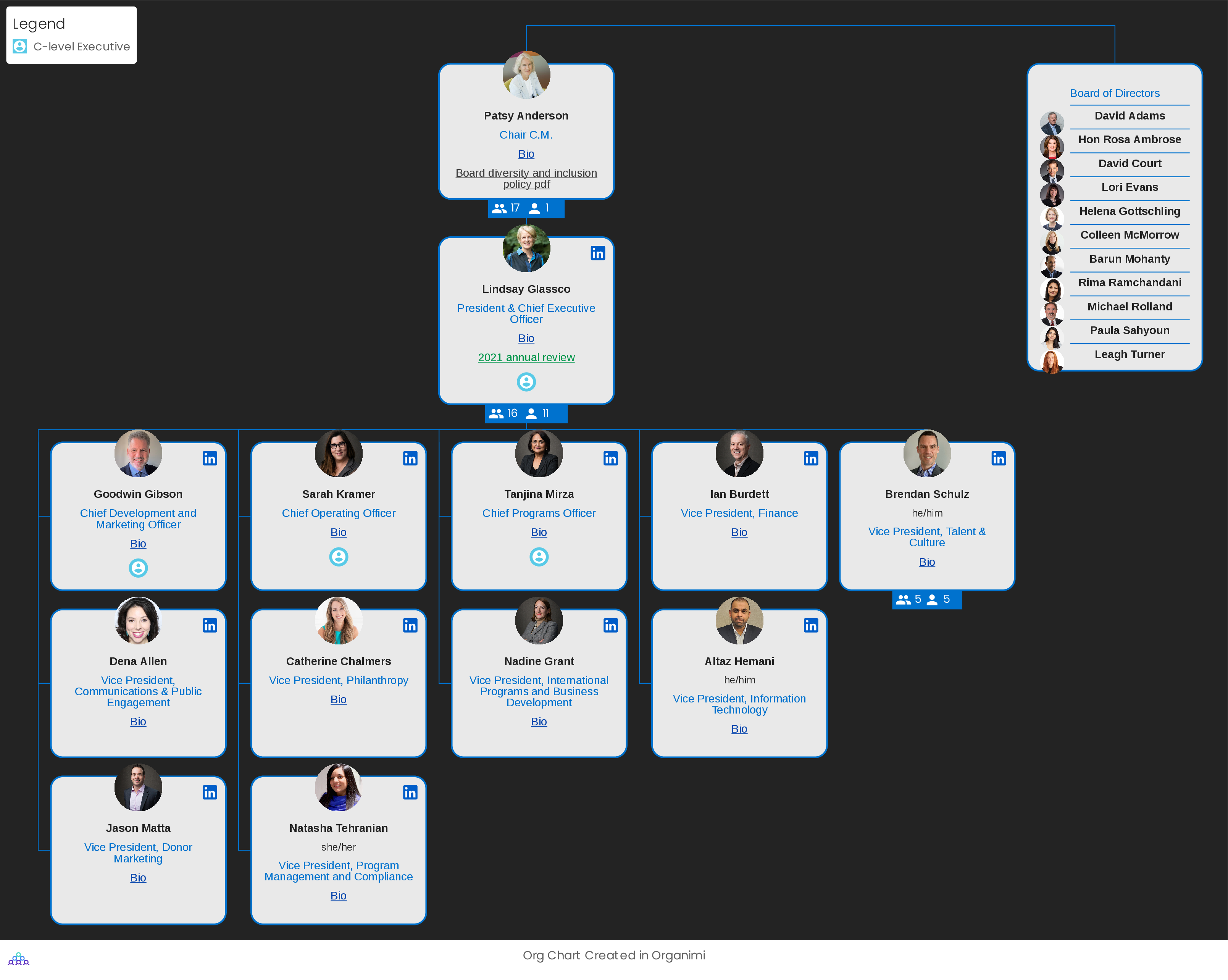Plan International’s Organizational Structure
Create this exact chart in Organimi! Scroll below to see how.
Introduction
Plan International Canada is the Canadian arm of Plan International, a not-for-profit development and humanitarian organization that was founded in 1937 as ‘Foster Parents Plan for Children in Spain’ during the Spanish Civil War. The organization was founded with the goal of providing food, accommodation, and education to children who had been caught up in the war.
Today, Plan International operates in over 75 countries worldwide including in Africa, the Americas, and Asia where their work advances children’s rights and equality for girls. The organization also focuses on child protection, health, education, economic security, sexual health, reproductive health and rights, and water and sanitation. The organization also provides training in disaster preparedness, response, and recovery.
In 1974, the organization was officially renamed to ‘Plan International’ following years of rapid growth which saw it break into other major markets including South America, Asia, and Africa.
Plan International in Canada
In 1968, the Canadian arm of the organization, ‘Foster Parents Plan of Canada’ as it was then known, was founded, furthering its expansion into North America after the founding of its United States mission some years earlier. Plan International Canada’s long-term goal is to empower children, their families, and the members of their communities to improve living conditions, build grassroots organizations, and work with local and national governments.
The organization works to break the cycle of child poverty by helping children and adults living in developing countries to develop their ideas and talents to shape the future. Prior to establishing a new worksite, Plan International Canada looks at community poverty statistics – infant mortality, Gross National Product, and other key factors – to determine where its resources are most needed.
With the assistance of donations and trained volunteers, Plan International Canada assists community participants in several areas including building schools and health clinics, educating teachers, providing vocational training, providing small business loans, and providing disaster-related humanitarian assistance.
In January 2010, Plan International Canada was one of the first NGOs to react to the Haiti earthquake. In 2011, with support from the Canadian government, Plan International pressured the United Nations into adopting October 11 as International Day of the Girl Child.
Plan International’s Global Leadership Team
Plan International’s global operations are overseen by the global leadership team.
Stephen Omollo is the current CEO, and he is supported by a team of Executive Directors who oversee operations across the organization’s four geographical regions – The Americas, Asia Pacific, Middle East, Eastern, and Southern Africa, and West and Central Africa.
Other Executive Directors on the global leadership team are responsible for functional areas such as resources, people and culture, finance, IT, communications, corporate governance, and legal.
Plan International as a global entity is managed under a geographical organizational structure. Some of the world’s largest organizations like Facebook (Meta) and Amazon use geographic structures because they enable reporting and functional systems across multiple locations. They also give separate sites and entities enough room to operate according to local demand while still being directed by business policy.
Plan International’s Leadership Team & Organizational Structure
Plan International Canada falls under the organization’s ‘Americas’ geographical unit which is overseen by Executive Director Debora Cobar.
Plan International Canada as an individual entity is led by President & CEO Lindsay Glassco. She is supported by her own executive team of C- and VP-level positions. These roles include among others:
- Chief Development and Marketing Officer
- Chief Operating Officer
- Chief Program Officer
- Vice President, Finance,
- Vice President, Communications and Public Engagement,
You can see Plan International Canada’s full executive leadership structure here:

In contrast to Plan International as a global entity that utilizes a geographic organizational structure, Plan International Canada as its own entity operates a classic hierarchical chain-of-command org structure where C- and VP-level roles wield ultimate authority over the departments that fall within their domain.
In this type of structure, decision-making power flows downwards with the President & CEO being the ultimate authority within the organization. Information and requests flow up the chain from employees on the ground to supervisors and department heads before ultimately, if necessary, reaching the C-level executive or VP responsible for that department who can relay it to the CEO if the situation requires it.
In larger organizations, as it is here, the chain of command is often split into many levels across three distinct tiers: senior management (e.g., CEO, Director, Senior Vice President), mid-level management (Regional Manager, Department Heads, Supervisor), and regular employees.
Learn more about organizational charts:
If you want to learn more about org structures and the important role that they play in organizations like Plan International, here are some resources that you can start with:
Create this chart in Organimi!
You can download the CSV file of Plan International’s org structure, import it into Organimi and start editing this chart right away! Here’s how:
- From your dashboard, select Data Import.
- Click the CSV tile.
- Click +Upload Your File.
- Select an Excel file from your device.
- In the Organization field, click the down arrow to select an organization.
- Click Create a New Chart
- Click Next and select: Organization Chart
- Select the auto-build tool to automatically build your chart.
- Voila!
Download CSV file: Plan-International (30.27 KB)
Plan-International (30.27 KB)
Build better org charts with
Organimi.
A powerful, cloud-based platform that helps you create, connect, and collaborate with your colleagues wherever they work.

